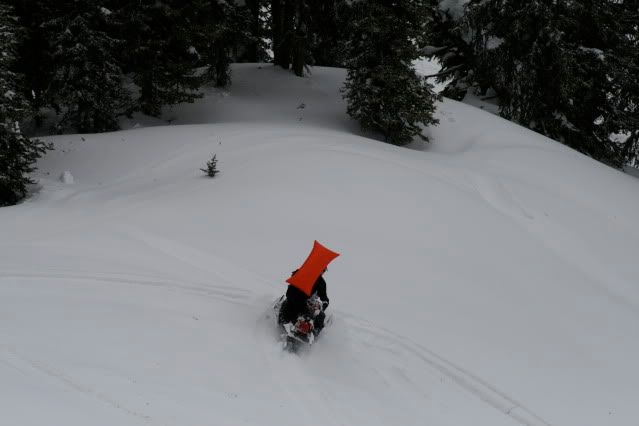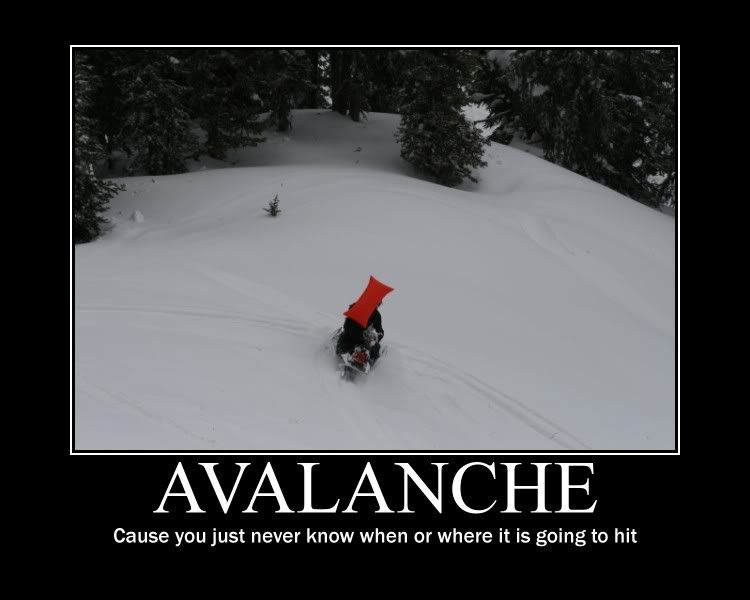Advantages of an ABS pack. Please compare to competitors.
ABS has 26 years of expertise in saving lives with statistics of over 226 lives saved. Only ABS can state that they have a 98% survival rate, with 90.7% unharmed! Of the 9.3% that sustained injuries there were NO head or spine injuries and the actual injuries were 0.5% torso, 5.3% arms/legs, and 3.5% contusions or slight injuries. Statistics should be a big part of the decision to purchase an avalanche airbag. Compare the ABS statistics to all our competitors!
As a snowmobiler in an avalanche you should deploy your airbag, then try and escape to the side of the avalanche. The ABS system will not impair your vision or exit speed, because of its proven design.
When in an avalanche different manufacturer’s airbags will react in different ways. The ABS will keep you on top of the snow on your stomach looking downhill. The reasons why this is advantageous are, if a victim is horizontal or level with the snow there is less chance of injury. The avalanche snow is not an even, liquid mass. What this means is there are different densities varying from powder snow, ice slabs to various sizes of chunks of snow that all move at different speeds. The dynamic forces within an avalanche are enormous. Avalanches have different layers that move at different speeds. A big reason the ABS works is it keeps you in the top layer. Some other advantages of the ABS are you can see what is in front of you or use your arms for protection, to steer or clean snow from your face. ABS has had testimonials stating that people have been able to avoid hitting trees in avalanches because of their design. In 26 years ABS has NOT had one case of head or neck trauma.
Look at where the airbags are attached on different makes of airbags. Hundreds of case studies have shown how crucial it is that the airbag is not fixed to the backpack. The ABS airbags are hinged to the backpack in a way that they are able to absorb erratic movements of the avalanche, thus giving a cushioning effect to the body. An airbag that is wrapped over the chest and head tends to keep the person more perpendicular, so you won’t stay parallel to the snow in the top layer. This could lead to a higher risk of injury because all the buoyancy is at one end of your body. Also, if there is flotation on the front of your body the system will make you go down the avalanche back first looking uphill, thus, greatly increasing the risk of spine, torso & back injury. Most snowmobilers use a moto-cross style helmet and in the first stages of being in the avalanche you will probably fill the front of the helmet area with snow. In a face up scenario it is harder to clear your airway. The theory that if buried, some airbags will give you breathable air to keep you alive is highly improbable because the snow will more than likely fill your mouth, airway and be packed around your head.
With an ABS, if you deploy your airbags you can keep riding until you reach a safe area then deflate the bags. They will not hamper your riding.
ABS has the largest amount of airbag volume available (170L) offering you more safety.
ABS uses nitrogen filled canisters. ABS‘s research shows that compressed air in a cold wet environment is unreliable and can freeze off too easily. All ABS canisters are professionally filled, thus there is no issue about getting someone to fill your canister properly or trying to find someone that can fill an air canister in a small town.
ABS canisters are also far more user friendly to take in and out of a pack.
What is new? ABS will offer a Carbon fiber canister option later this winter. This canister will be less than half the weight of the currently used canister.
For next season, ABS will have a remote control wireless activation unit, giving you the option to deploy one of your group’s airbags if they don’t realize they are in danger.
In closing, you should buy whatever product you feel will give you the best safety. Compare the stats, compare the design, and remember why you are buying it.
Thanks for your time.
ABS has 26 years of expertise in saving lives with statistics of over 226 lives saved. Only ABS can state that they have a 98% survival rate, with 90.7% unharmed! Of the 9.3% that sustained injuries there were NO head or spine injuries and the actual injuries were 0.5% torso, 5.3% arms/legs, and 3.5% contusions or slight injuries. Statistics should be a big part of the decision to purchase an avalanche airbag. Compare the ABS statistics to all our competitors!
As a snowmobiler in an avalanche you should deploy your airbag, then try and escape to the side of the avalanche. The ABS system will not impair your vision or exit speed, because of its proven design.
When in an avalanche different manufacturer’s airbags will react in different ways. The ABS will keep you on top of the snow on your stomach looking downhill. The reasons why this is advantageous are, if a victim is horizontal or level with the snow there is less chance of injury. The avalanche snow is not an even, liquid mass. What this means is there are different densities varying from powder snow, ice slabs to various sizes of chunks of snow that all move at different speeds. The dynamic forces within an avalanche are enormous. Avalanches have different layers that move at different speeds. A big reason the ABS works is it keeps you in the top layer. Some other advantages of the ABS are you can see what is in front of you or use your arms for protection, to steer or clean snow from your face. ABS has had testimonials stating that people have been able to avoid hitting trees in avalanches because of their design. In 26 years ABS has NOT had one case of head or neck trauma.
Look at where the airbags are attached on different makes of airbags. Hundreds of case studies have shown how crucial it is that the airbag is not fixed to the backpack. The ABS airbags are hinged to the backpack in a way that they are able to absorb erratic movements of the avalanche, thus giving a cushioning effect to the body. An airbag that is wrapped over the chest and head tends to keep the person more perpendicular, so you won’t stay parallel to the snow in the top layer. This could lead to a higher risk of injury because all the buoyancy is at one end of your body. Also, if there is flotation on the front of your body the system will make you go down the avalanche back first looking uphill, thus, greatly increasing the risk of spine, torso & back injury. Most snowmobilers use a moto-cross style helmet and in the first stages of being in the avalanche you will probably fill the front of the helmet area with snow. In a face up scenario it is harder to clear your airway. The theory that if buried, some airbags will give you breathable air to keep you alive is highly improbable because the snow will more than likely fill your mouth, airway and be packed around your head.
With an ABS, if you deploy your airbags you can keep riding until you reach a safe area then deflate the bags. They will not hamper your riding.
ABS has the largest amount of airbag volume available (170L) offering you more safety.
ABS uses nitrogen filled canisters. ABS‘s research shows that compressed air in a cold wet environment is unreliable and can freeze off too easily. All ABS canisters are professionally filled, thus there is no issue about getting someone to fill your canister properly or trying to find someone that can fill an air canister in a small town.
ABS canisters are also far more user friendly to take in and out of a pack.
What is new? ABS will offer a Carbon fiber canister option later this winter. This canister will be less than half the weight of the currently used canister.
For next season, ABS will have a remote control wireless activation unit, giving you the option to deploy one of your group’s airbags if they don’t realize they are in danger.
In closing, you should buy whatever product you feel will give you the best safety. Compare the stats, compare the design, and remember why you are buying it.
Thanks for your time.
Last edited:




